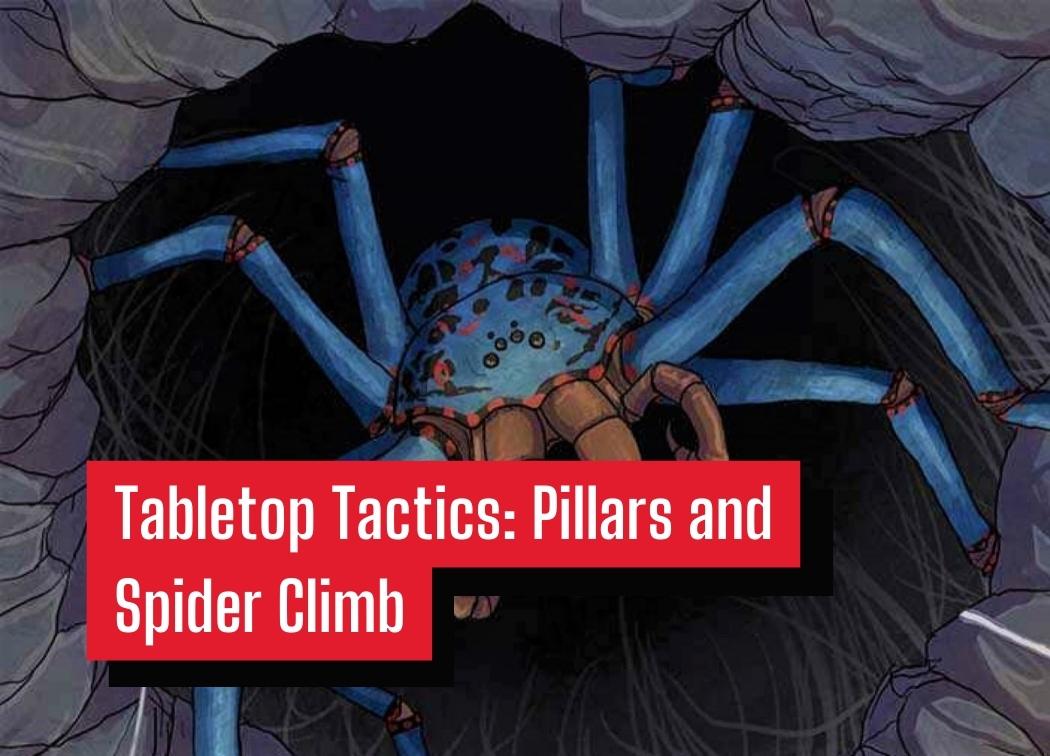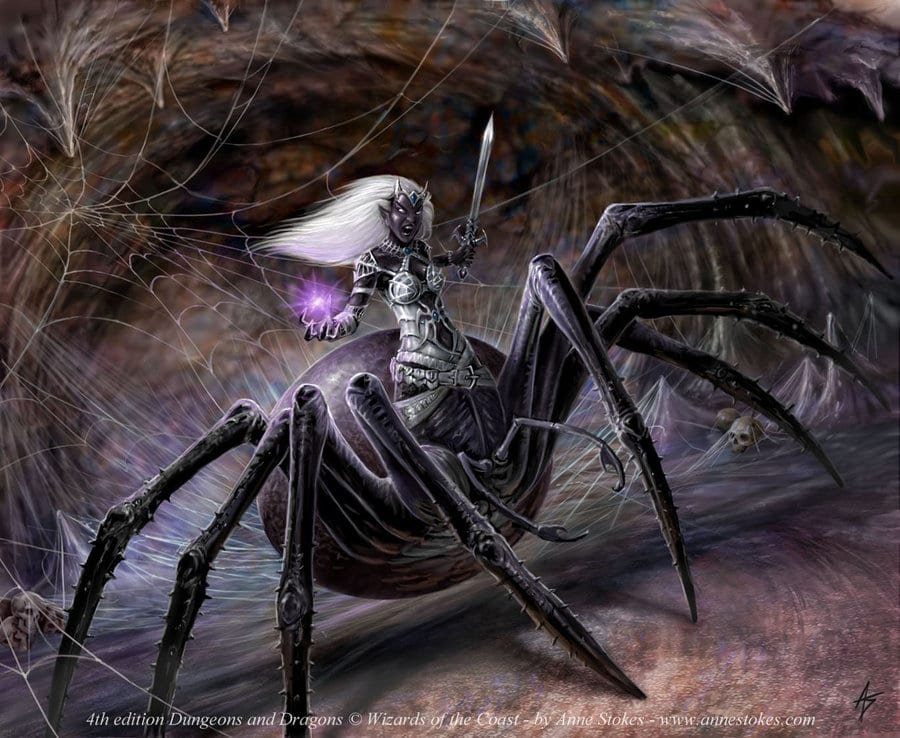Tabletop Tactics: Pillars and Spider Climb

This past week I ran perhaps the greatest boss fight I’ve ever created in D&D 5e. While the homebrew version of Lolth that I created was deadly, flavorful, and annoying to play against, that wasn’t what made the fight so challenging. No, it was a few 100 ft. tall pillars, Spider Climb, and Web Walking that sealed the deal.
It’s interesting because when people talk about encounter design in 5e, a lot of the discussion (correctly) revolves around selecting the best creatures. However, I find that not enough people think about what the battlefield brings to the table.
Giving the party and/or the enemy terrain to hide behind incorporates line of sight and cover. Adding rocky outcroppings, trenches, pillars, etc. gives creatures with a climb speed the ability to outmaneuver their enemy. All of these environmental features have an impact on the combat encounter, but their impact isn’t easy to quantify.
So for this installment of Tabletop Tactics, let’s talk about how to use Spider Climb and vertical surfaces like pillars to spice up all of your drider (and other such creatures) encounters!

Background Info
I’m not going to waste your time making sense of a 3 year-long campaign’s conclusion of how the party’s warlock was tricked by Lolth into believing she was his patron (she was technically, but he thought he served someone else) so that the party would inadvertently bust her out of her prison.
A bunch of other stuff happens, everything spirals out of control, and the party has to confront Lolth and kick her out of the Material Plane. This all finally came to a head this past week.
The first step of my encounter design was to homebrew a version of Lolth that would be a deadly fight for four 14th-level characters. The second step was to design the room in a way that could aid her in a fight where she was outnumbered.
I gave Lolth Spider Climb and Webwalker which are two common features for giant spiders, driders, and other such creatures. These traits do the following:
Spider Climb. The creature can climb difficult surfaces, including upside down on ceilings, without needing to make an ability check.
Web Walker. The craeture ignores movement restrictions caused by webbing.
The encounter took place in a throne room which Lolth and a few of her trusted driders had lived in for some time. The entire room, including the ceiling, columns, and walls, was covered in sticky webbing causing difficult terrain for anyone without the Web Walker trait.
With this in mind, I created a throne room battlemap that had plenty of large columns for Lolth and her minions to skitter upon as needed. This became an enormous issue for the party as they moved at half of their movement speed due to the terrain making it difficult to give the rogue opportunities to use Sneak Attack and limited their spell choices.
The Benefits of this Tactic
Safely Lob Ranged Attacks at Your Foes
I gave Lolth a powerful ranged weapon attack that was on-par with her melee attacks. She also had a hearty spell list with spells like Dominate Person/Monster and Divine Word. Simply put, she was an effective foe from afar, even if her melee attacks were more devastating.
The first round of combat had Lolth smash into the party head-on and make quick attacks with her magical rapier. After that, I decided to make things tricky for the party’s rogue and have her eat a couple of attacks of opportunity to put some distance between herself and the party.
Lolth continued to retreat the following turn and was able to move up a column thanks to also having a legendary action that gave her extra movement. From there I continued to have her scurry up the column and onto the ceiling, all the while peppering the party with ranged attacks.
The majority of the encounter had at least one party member downed thanks to this tactic. Well, that and mind-controlling the party’s Witch for the majority of the encounter.
Give Melee Units the Run-Around
While the party has three spellcasters in it, the rogue tends to get a lot of time in the limelight due to his consistently-high burst damage. This was an encounter that revolved around the party’s warlock so I felt that it would be pertinent to make it so that the warlock had the opportunity to have some epic moments.
Web Walker and Spider Climb both gave the rogue a very difficult time, making it a challenge for him to get in more than just a couple of melee attacks throughout the fight. His magical ranged weapon was still useful and did a fair bit of chip damage, but he was not able to consistently proc Sneak Attack due to Lolth being up 70-100+ ft. above the party most of the fight.
He could’ve probably used the surrounding area better to hide and give himself advantage for Sneak Attack, but the difficult terrain did make that a challenge.
The party also has a fair amount of melee or close-ranged spells that they love to use. This fight made everyone dig deep and think outside of the box due to Lolth being able to put such an enormous amount of distance between them.
It was not a good day to be a melee character, let’s leave it at that.
The Drawback: You’re Stuck Up There!
Eventually, though, the party was able to bait out Lolth’s three Counterspells and three Legendary Resistances. At this point, Lolth’s fate was tied to the dice and her rather generous saving throw bonuses.
Seeing as the party was low, and she needed to finish them quickly, Lolth began making her way down toward the party to get in range for a Divine Word. Once the party realized that she was trying to do this, they used a few spells to completely turn the tables on Lolth, much to my surprise.
Using the columns as a surface, the party was able to cast spells like Blade Barrier which hindered Lolth’s once impressive movement speed. I was so annoyed… but so proud. It was an excellent show of using spells to seize battlefield control from an enemy.
This allowed the Warlock to keep blasting Lolth. Eventually, the party was able to dispose of her before she got close enough to cast her encounter-ending Divine Word.
While the columns and ceiling were once a refuge from the party’s most dangerous attacks, they quickly became a prison for Lolth after she had no way to shake off the party’s crowd control spells and abilities.
Conclusions
The most obvious usage of Spider Climb is to hang from the ceiling and pepper the enemy with deadly ranged attacks. However, in the heat of battle, it’s not always easy for a creature with Spider Climb to disengage from the party to rush toward the nearest wall to climb up.
Adding objects such as pillars, boulders, statues, or any other tall surfaces a creature could climb up gives these creatures another option to disengage from the party and utilize their climb speed to potentially grant them some additional survivability in the form of avoiding melee and short-ranged attacks.
The party has two choices when a creature seeks to disengage in such a manner. The first option is to prevent the creature from reaching the object they’re moving towards. The second is to trap the creature up on the ceiling, preventing the creature from escaping if the situation begins to look dire.
I opted to nix the first option by using spider webs to slow the party, but the second option was executed well-enough that it caused Lolth’s demise. Though I will say, the victory cost the party many consumables and a few members had close calls with death.
All in all, it was a successful encounter, but more importantly, an excellent way to showcase the power of Spider Climb and Web Walker in combat!

It’s always good to make an interesting battlefield which allows the players to think about using the terrain to their advantage. Thanks for the article.